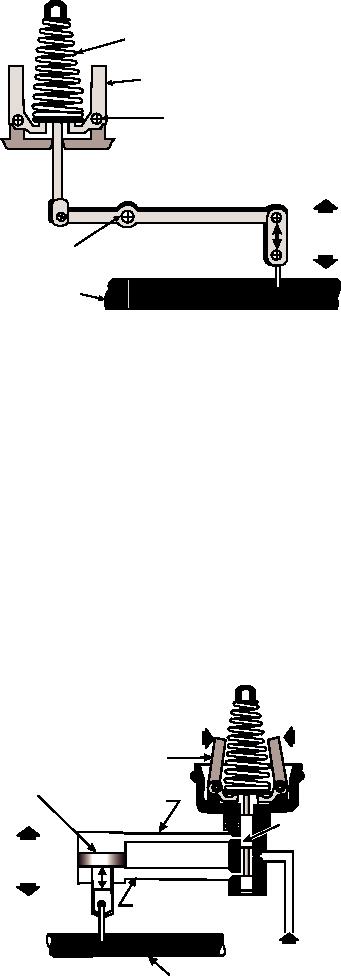
increased, the engine speed decreases, resulting in a
reduction in the centrifugal force of the flyballs. The
SPRINGS
spring tension then becomes the greater force, and it
acts on the fuel-control mechanism to increase the
F LY B A L L
quantity of fuel delivered to the engine. The increase in
fuel results in an increase in engine speed until balance
FULCRUM
of the forces is again reached.
When the load on an engine is reduced or removed,
the engine speed increases and the centrifugal force
within the governor increases. The centrifugal force
then becomes greater than the spring tension and acts
FUEL ON
on the fuel control linkage to reduce the amount of fuel
FULCRUM
FUEL OFF
delivered to the cylinders. This causes the engine speed
to decrease until a balance between the opposing forces
FUEL PIPE
is again reached and engine speed becomes constant.
ASf04030
OTHER CLASSIFICATIONS OF GOVERNORS
Figure 4-30.--Simple mechanical governor.
Governors are also classified according to the
method by which fuel-control mechanisms are
fuel supply causes an increase in engine power output
regulated. In some cases, the centrifugal force of the
and speed. The governor regulates the fuel supply so
rotating weights regulates the fuel supply directly,
that enough power is developed to handle the increase
through a mechanical linkage that operates the
in load.
fuel-control mechanism. Other governors are designed
so that the centrifugal force of the rotating weights
Hydraulic governors are more sensitive than those
regulates the fuel supply indirectly by moving a
of the mechanical type. Also, the design of a hydraulic
hydraulic pilot valve that controls oil pressure. Oil
governor enables a comparatively small governing unit
pressure is then exerted on either side of a power piston
to control the fuel mechanism of a large engine. The
that operates the fuel-control mechanism.
mechanical governor is used more often on small
engines, which do not require extremely close
Governors that regulate the fuel supply directly
regulation of the fuel. Hydraulic governors are more
(through mechanical linkage) are called "mechanical"
suitable to large engines, in which more accurate
governors, and those that control the fuel supply
regulation of fuel is necessary.
indirectly (through oil pressure) are called "hydraulic"
governors. Simple governors of the mechanical and
hydraulic types are shown in figures 4-30 and 4-31,
respectively.
Note that in the illustration of the mechanical
governor, the weights, or flyballs, are in an upright
FLYBALL
POWER
position. This indicates that the centrifugal force of the
PISTON
weights and the tension of the spring are balanced; in
PASSAGE "A"
other words, the engine is operating at constant load
PILOT VALVE
and speed. In the case of the hydraulic governor, the
FUEL O N
positions of the parts indicate that the engine is
responding to an increase in load with a resulting
FUEL OFF
decrease in engine speed. Note that the weights tilt
PASSAGE "B"
inward at the top. As engine speed decreases, the spring
tension overcomes the centrifugal force of these
rotating weights. When the spring tension is greater
FROM PUMP
than the centrifugal force of the flyballs, the governor
FUEL PIPE
mechanism acts to permit oil under pressure to force the
ASf04031
piston to increase the fuel valve opening. The increased
Figure 4-31.--Simple hydraulic governor.
4-24

